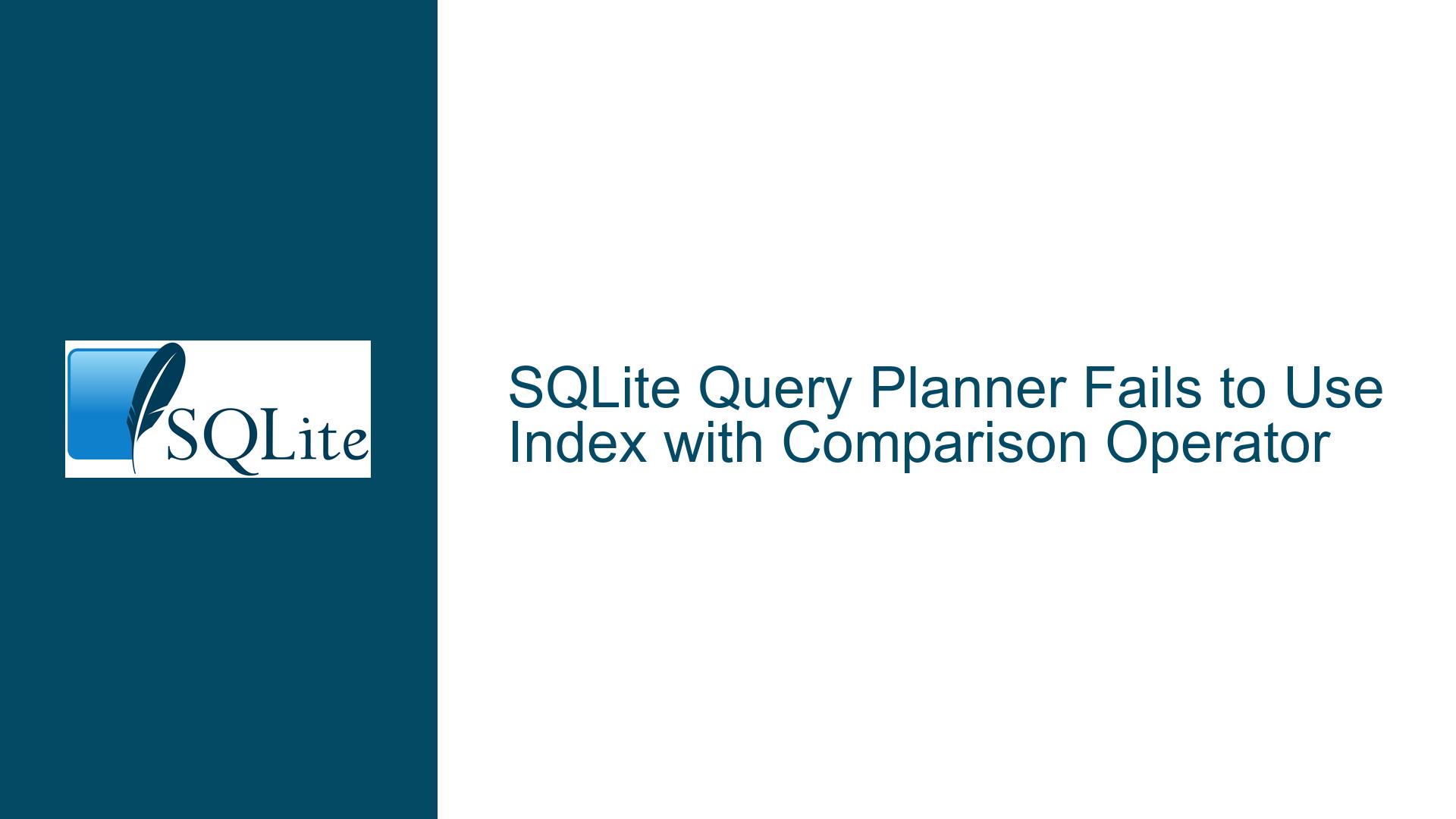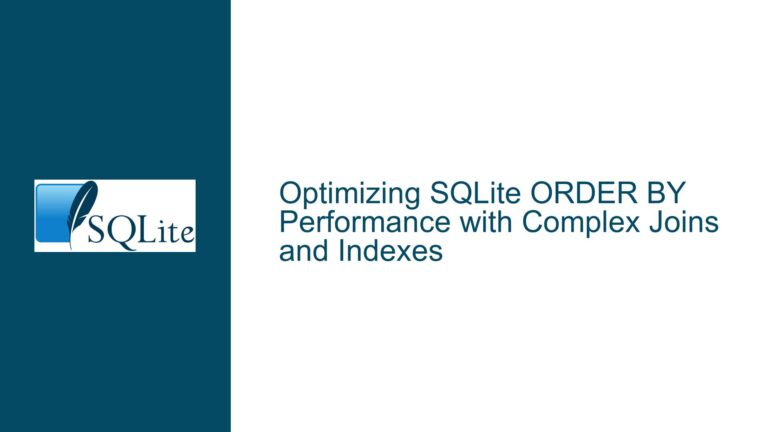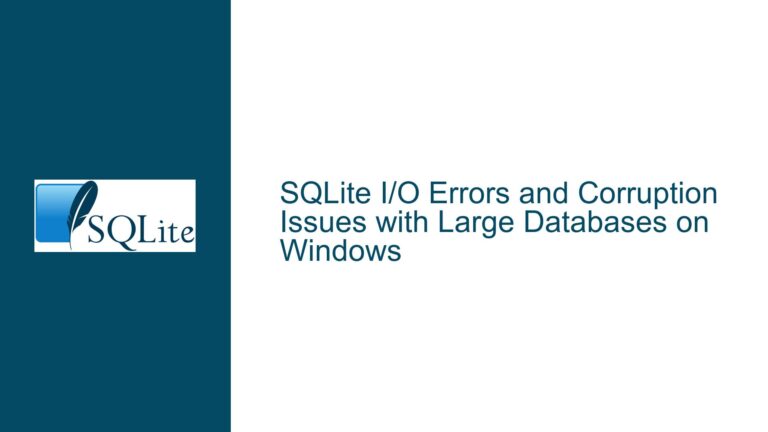SQLite Query Planner Fails to Use Index with Comparison Operator
Query Planner Ignores Index for key_id >= 1 Condition
In SQLite, the query planner is responsible for determining the most efficient way to execute a query. However, there are cases where the query planner may fail to use an obvious index, particularly when certain comparison operators are involved. Consider the following schema:
CREATE TABLE test (id INTEGER PRIMARY KEY, key_id INTEGER);
CREATE INDEX test_key_idx ON test(key_id);
When executing the query:
EXPLAIN QUERY PLAN
SELECT MIN(id) FROM test WHERE key_id >= 1;
The query planner may choose to perform a full table scan (SEARCH TABLE test) instead of utilizing the test_key_idx index. This behavior can lead to significant performance degradation, especially when dealing with large datasets. Interestingly, alternative queries such as:
EXPLAIN QUERY PLAN
SELECT MIN(id) FROM test WHERE key_id BETWEEN 1 AND 999999;
or even:
SELECT MIN(id) FROM test WHERE key_id BETWEEN 1 AND (SELECT MAX(key_id) FROM test);
do utilize the test_key_idx index, resulting in faster execution times. This discrepancy raises questions about why the query planner behaves differently for seemingly similar queries and what factors influence its decision-making process.
Query Planner’s Cost Estimation and Index Selection
The query planner’s decision to use or ignore an index is based on its cost estimation algorithm. This algorithm evaluates the potential cost of different execution plans and selects the one it deems most efficient. In the case of the query SELECT MIN(id) FROM test WHERE key_id >= 1;, the query planner may determine that a full table scan is more efficient than using the index. This decision is influenced by several factors:
Data Distribution: If the majority of rows in the table satisfy the condition
key_id >= 1, the query planner may conclude that scanning the entire table is more efficient than using the index. This is because the index would still require scanning a large portion of its entries, and the additional overhead of index traversal might not justify the potential benefits.Index Coverage: The
test_key_idxindex is a non-covering index for the querySELECT MIN(id) FROM test WHERE key_id >= 1;. This means that the index does not contain all the information required to satisfy the query. Specifically, the index containskey_idandid, but the query planner may still need to access the table to retrieve additional information, which adds overhead.Cost of Index Traversal: Traversing an index involves additional steps compared to a simple table scan. The query planner must weigh the cost of traversing the index against the cost of scanning the table. If the query planner estimates that the cost of index traversal is higher, it may opt for a full table scan.
Statistical Information: The query planner relies on statistical information about the table and its indexes to make informed decisions. If this information is outdated or incomplete, the query planner may make suboptimal choices. Running the
ANALYZEcommand can update the statistical information and potentially improve the query planner’s decisions.Query Complexity: The query planner’s cost estimation becomes more complex when dealing with queries that involve aggregates (e.g.,
MIN,MAX) or subqueries. In such cases, the query planner must consider the cost of evaluating the aggregate or subquery in addition to the cost of accessing the table or index.
Optimizing Query Performance with Index Usage
To address the issue of the query planner ignoring the index for the key_id >= 1 condition, several strategies can be employed:
Use the
BETWEENOperator: As demonstrated in the original discussion, replacing the>=operator with theBETWEENoperator can encourage the query planner to use the index. For example:SELECT MIN(id) FROM test WHERE key_id BETWEEN 1 AND 999999;This approach works because the
BETWEENoperator provides a clear upper bound, which allows the query planner to estimate the number of rows that need to be scanned more accurately.Force Index Usage: SQLite allows you to force the query planner to use a specific index using the
INDEXED BYclause. For example:SELECT MIN(id) FROM test INDEXED BY test_key_idx WHERE key_id >= 1;This approach can be useful in cases where you are confident that using the index will result in better performance. However, it should be used with caution, as it overrides the query planner’s decision-making process and may lead to suboptimal performance in some cases.
Update Statistical Information: Running the
ANALYZEcommand updates the statistical information used by the query planner, which can improve its decision-making process. For example:ANALYZE;This command collects statistics about the distribution of data in the table and its indexes, allowing the query planner to make more informed decisions.
Consider Index Design: In some cases, the design of the index itself may influence the query planner’s decision. For example, creating a covering index that includes all the columns required by the query can eliminate the need for the query planner to access the table, making index usage more attractive. For example:
CREATE INDEX test_key_covering_idx ON test(key_id, id);This index includes both
key_idandid, making it a covering index for the querySELECT MIN(id) FROM test WHERE key_id >= 1;.Evaluate Query Rewrites: In some cases, rewriting the query can encourage the query planner to use the index. For example, the following query uses a subquery to find the maximum value of
key_id, which can help the query planner estimate the number of rows that need to be scanned:SELECT MIN(id) FROM test WHERE key_id BETWEEN 1 AND (SELECT MAX(key_id) FROM test);This approach can be particularly useful when the distribution of
key_idvalues is not uniform.Compile with
SQLITE_ENABLE_STAT4: TheSQLITE_ENABLE_STAT4compile-time option enables more advanced statistical analysis, which can improve the query planner’s ability to estimate the cost of different execution plans. If this option is enabled, running theANALYZEcommand will collect more detailed statistics, which can help the query planner make better decisions.Monitor Query Performance: Regularly monitoring the performance of your queries can help you identify cases where the query planner is making suboptimal decisions. Tools such as
EXPLAIN QUERY PLANandsqlite3_tracecan provide insights into the query planner’s decision-making process and help you identify potential optimizations.
In conclusion, the query planner’s decision to ignore an index for a key_id >= 1 condition is influenced by several factors, including data distribution, index coverage, and the cost of index traversal. By understanding these factors and employing strategies such as using the BETWEEN operator, forcing index usage, updating statistical information, and optimizing index design, you can improve the performance of your queries and ensure that the query planner makes the best possible decisions.






